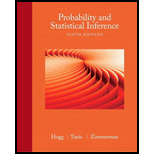
Concept explainers
For each of the following
(a)
(b)
(c)
(d)
Want to see the full answer?
Check out a sample textbook solution
Chapter 4 Solutions
Probability and Statistical Inference (9th Edition)
Additional Math Textbook Solutions
Elementary & Intermediate Algebra
Elementary Statistics (13th Edition)
Calculus: Early Transcendentals (2nd Edition)
Introductory Statistics
Elementary Statistics: A Step By Step Approach
- The joint density function of two continuous random variables X and Y is: p(x, y) = {Kcos(x + y) Find (i) the constant K 0 0arrow_forwardp(x,y) = {e-x -(x+y) 0 x ≥ 0, y ≥ 0 otherwise find x,y,Exy, by Охarrow_forwardIf X is a continuous random variable having pdf as shown. Find a) the constant k b) P(X>1) c) X, X², 0%, standard deviation. n(x) k -2 -1 0 1 2arrow_forwardThe joint probability function for the random variables X and Y is y 0 1 2 P(X, Y) = x0 [3/28 9/28 3/281 = 13/14 3/14 2 1/28 0 0 0 Find Mx, My, E(XY), OXY.arrow_forwardP(x, y) = {e-(x+y) x≥0, y ≥0 0 otherwise find x, y, x,y JX, 4 буarrow_forwardThe joint density function of two continuous random variables X and Y is: p(x, y) = {Kcos(x- Find (i) the constant K + y) 0 0arrow_forwardA random variable X has a Gaussian distribution. The mean value of X is 2 and the variance is 4 volts. Compute the following probabilities: a) P(X3) c) P(X<-2) d) P(2arrow_forwardLet X and Y be random variables having joint density function 0≤x≤1,0≤ y ≤ 1 find X, Y, 0, 0, OXY otherwise p(x,y) = {x+yarrow_forwardFind the probability in tossing a fair coin three times, there will appear a) 3 H b)2 H 1T c) 2 T and 1 H d) 3 T.arrow_forwardLet the random variable X represents the number of automobiles that are used for different business purpose on any given workday. Xi p(xi) 1 0.3 Find: a) μx b)X2 c) o 2 2 3 0.4 0.3arrow_forwardsurvey of 5050 young professionals found that they spent an average of $20.5620.56 when dining out, with a standard deviation of $11.4111.41. Can you conclude statistically that the population mean is greater than $2323? Use a 95% confidence interval. Question content area bottom Part 1 The 95% confidence interval is left bracket nothing comma nothing right bracketenter your response here, enter your response here. As $2323 is ▼ of the confidence interval, we ▼ can cannot conclude that the population mean is greater than $2323. (Use ascending order. Round to four decimal places as needed.)arrow_forwardQ5: 06: the foot lies between 3 and 4. (20 Marks) Let f(x) = 3*, use Lagrange interpolation to find a second-degree polynomial that agrees with this function at the points x₁ = 0, x₁ = 1, x2 = 2.arrow_forwardarrow_back_iosSEE MORE QUESTIONSarrow_forward_iosRecommended textbooks for you
 Linear Algebra: A Modern IntroductionAlgebraISBN:9781285463247Author:David PoolePublisher:Cengage Learning
Linear Algebra: A Modern IntroductionAlgebraISBN:9781285463247Author:David PoolePublisher:Cengage Learning
 Linear Algebra: A Modern IntroductionAlgebraISBN:9781285463247Author:David PoolePublisher:Cengage LearningStatistics 4.1 Point Estimators; Author: Dr. Jack L. Jackson II;https://www.youtube.com/watch?v=2MrI0J8XCEE;License: Standard YouTube License, CC-BYStatistics 101: Point Estimators; Author: Brandon Foltz;https://www.youtube.com/watch?v=4v41z3HwLaM;License: Standard YouTube License, CC-BYCentral limit theorem; Author: 365 Data Science;https://www.youtube.com/watch?v=b5xQmk9veZ4;License: Standard YouTube License, CC-BYPoint Estimate Definition & Example; Author: Prof. Essa;https://www.youtube.com/watch?v=OTVwtvQmSn0;License: Standard Youtube LicensePoint Estimation; Author: Vamsidhar Ambatipudi;https://www.youtube.com/watch?v=flqhlM2bZWc;License: Standard Youtube License
Linear Algebra: A Modern IntroductionAlgebraISBN:9781285463247Author:David PoolePublisher:Cengage LearningStatistics 4.1 Point Estimators; Author: Dr. Jack L. Jackson II;https://www.youtube.com/watch?v=2MrI0J8XCEE;License: Standard YouTube License, CC-BYStatistics 101: Point Estimators; Author: Brandon Foltz;https://www.youtube.com/watch?v=4v41z3HwLaM;License: Standard YouTube License, CC-BYCentral limit theorem; Author: 365 Data Science;https://www.youtube.com/watch?v=b5xQmk9veZ4;License: Standard YouTube License, CC-BYPoint Estimate Definition & Example; Author: Prof. Essa;https://www.youtube.com/watch?v=OTVwtvQmSn0;License: Standard Youtube LicensePoint Estimation; Author: Vamsidhar Ambatipudi;https://www.youtube.com/watch?v=flqhlM2bZWc;License: Standard Youtube License